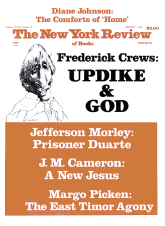In response to:
The Siege from the September 25, 1986 issue
To the Editors:
C. Vann Woodward gives us a thoughtful review of McCarthyism, in his September 25 article. Then he gratifies his “historian’s appetite for comparison” by putting beside the damage done by McCarthysim “the toll taken by the assault on academic freedom from the left in the Sixties and Seventies.”
I object. First, mightn’t an historian look at the historical process, and even at causes, rather than just plucking out decades to see how they compare? To state the obvious: the complicity of the universities in cold war politics, which McCarthyism had helped to create, was what provoked the anger of so many students and teachers in the Sixties. And there was no “left” to lead the “assault,” at the beginning—McCarthyism had seen to that. We were liberals at first, who came to see how the universities were betraying their and our professed values.
Second, Woodward’s picture of disruption, pillage, arson, etc., greatly distorts the movement and its impact. Most of us never went beyond rudeness. As for our intimidation of center and right (“books not written, research not done…”): this is fantasy. Center and right scholarship and teaching remained dominant through the period of most intense debate, and are dominant today. The “left’s” main impact on academic freedom was greatly to increase it. Ideas and outlooks forcibly eliminated from academic discourse in the McCarthy period became available again, to the great enrichment of scholarship and teaching, nowhere more than in Professor Woodward’s own field. How about a little credit to us, for helping to repair the damage of McCarthyism?
Richard Ohmann
Wesleyan University
Middletown, Connecticut
C Vann Woodward replies:
Unsure of just what bearing Professor Smith’s discussion of scholarly objectivity has on Ellen Schrecker’s book on McCarthyism or my review of it, I shall confine my comments to his last two paragraphs. Here he takes exception to my treatment of violations of academic freedom in the 1950s and the 1960s, contending that I am making “a serious error to equate, even roughly,” the two eras. I really do not think I can be said to “equate” them. I compare them and am at pains to say the comparison is “one of sharp contrasts.” There could hardly be a sharper contrast than the ends pursued by the right-wing politicians and the left-wing students. The similarity I point to is the denial of freedom and use of coercion both right and left employed as means to attain their ends. On this he and I appear to be in agreement, for he says that “noble convictions of tens of thousands of students often resulted in violence and coercion, in the denial of free speech, the occupation of administration buildings and many other doubtless excessive acts.” Where we differ is in the significance we attach to freedom in universities and these assaults upon it. He seems to justify assaults of the left as “guerrilla theater” to dramatize issues. While admitting that these acts were often “wildly irrational,” he contends that they “constituted one of the more encouraging moments in our history,” and yearns for a recurrence. I have encountered nostalgia for the exciting Sixties among present-day under-graduates, and even among some participants who remember the period, but rarely among survivors of Professor Smith’s mature years.
To Professor Ohmann’s reasonable plea for justice to the student rebels of the Sixties I would reply: credit where credit is due; an A for motives, a D for methods; praise for ends, probation for means. In proposing to compare the Fifties with the Sixties I began, as I have said, by writing that “the comparison would be partly one of sharp contrasts.” I added later that as for “the relative worthiness of the causes” that were sought by McCarthyites on the one hand and the student rebels on the other “there were obvious differences of significance.” I think that I left no doubt about my distaste for the ends sought by the right-wing politicians. By contrast I pointed out that the student movement contributed substantially to “the mightiest social upheaval of the era, the civil rights movement for black rights” and “the struggle to stop the Vietnam War.” I sympathized strongly with both causes and so, I believe, did the majority of the faculty people of that time.
The point at issue is the means employed for the ends sought. I agree with Professor Ohmann that the majority of student rebels “never went beyond rudeness.” But he would have to admit that forcible disruption of speeches, lectures, and classes, coercion of administrators, violence against libraries, laboratories, and destruction of faculty papers and manuscripts did take place. The significant thing is not how much of this was done, but rather the palpable threat of its occurring at all, anywhere and any time. In the McCarthyite siege only a hundred or so professors were actually sacked, but how many decapitations are required to spread the message that deviation is dangerous?
Granted that participatory chaos enlivened the academic scene, that for a time there was rarely a dull moment, that the rebels put to shame much sham and pretense cloaked in robes of authority and exposed university complicity in cold-war politics. Granted also that scholarship and teaching profited sometimes by being jolted out of stale routine and convention. But at what appalling cost to standards and values! Inflated grades with As for all who would not settle for a B and the total disappearance of failures; the collapsed thresholds of admission, appointment, and promotion; the deterioration of scholarly discourse into “raps” and “relevance”; the trivialization of the curriculum with courses in astrology, soul food, and joyful sex. And most embarrassing of all, the Beautiful People, the co-opted faculty members and their Life Styles who affected the costumes, adopted the argot, and embraced the manners of the young.
This Issue
December 4, 1986



